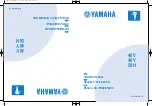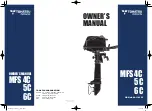
3-3
Chapter 3: Troubleshooting
3. If you still cannot resolve the problem, include the following information when
contacting us for technical support:
Serverboard model and PCB revision number
BIOS release date/version (this can be seen on the initial display when your
system fi rst boots up)
System
confi
guration
An example of a Technical Support form is posted on our web site.
4. Distributors: For immediate assistance, please have your account number ready
when contacting our technical support department by e-mail.
3-3 Frequently
Asked
Questions
Question: What type of memory does my serverboard support?
Answer:
The H8DSP-8/H8DSP-i supports up to 32 GB of registered ECC
DDR333/266 or up to 16 GB of registered ECC DDR400 interleaved or non-inter-
leaved SDRAM with two CPUs installed. With only one CPU installed the maximum
memory support is halved. See Section 2-4 for details on installing memory.
Question: How do I update my BIOS?
Answer:
It is recommended that you
not
upgrade your BIOS if you are not experi-
encing problems with your system. Updated BIOS fi les are located on our web site.
Please check our BIOS warning message and the information on how to update
your BIOS on our web site. Also, check the current BIOS revision and make sure
it is newer than your current BIOS before downloading.
Select your mainboard model on the web page and download the corresponding
BIOS fi le to your computer. Unzip the BIOS update fi le, in which you will fi nd the
readme.txt (fl ash instructions), the amifl ash.exe (BIOS fl ash utility) and the BIOS
image (xxx.rom) fi les. Copy these fi les to a bootable fl oppy disk, insert the disk
into drive A and reboot the system. At the DOS prompt after rebooting, enter the
command "amifl ash" (without quotation marks) then type in the BIOS fi le that you
want to update with (xxxx.rom).
Question:
What's on the CD that came with my serverboard?
Answer:
The supplied compact disc has quite a few drivers and programs that will
greatly enhance your system. We recommend that you review the CD and install the
applications you need. Applications on the CD include chipset drivers for Windows
and security and audio drivers.
















































